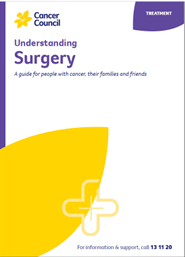- Home
- Bladder cancer
- Superficial bladder cancer treatment
- Surgery: TURBT
Surgery: TURBT
Most people with superficial bladder cancer have an operation called transurethral resection of bladder tumour or TURBT. This procedure is usually done during diagnosis.
If the cancer has spread to the lamina propria or is high grade, you may need a second TURBT 2–6 weeks after the first procedure to make sure that all cancer cells are removed. If the cancer comes back after initial treatment, your surgeon may do another TURBT or suggest removing the bladder in an operation called a cystectomy.
Learn more about:
How the surgery is done
This procedure is done in hospital under general anaesthetic and takes up to 45 minutes. In some cases, a TURBT may be the only procedure needed to treat the cancer.
The rigid cystoscope is passed through the urethra into the bladder so the surgeon can see the inside of your bladder on a monitor. The surgeon may remove the tumour through the urethra using a wire loop on the end of the cystoscope. Other methods for destroying the cancer cells include burning the base of the tumour with an electrical current (fulguration) or using a high-energy laser. A TURBT does not involve any cuts to the outside of the body.
The removed tissue will be examined for signs of cancer. Results are usually available in 5–7 days. See below for more information about what to expect after a TURBT.
For more on this, see our general section on Surgery.
What to expect after a TURBT
Most people who have a TURBT stay in hospital for 1–2 days. Your body needs time to heal after the surgery.
Having a catheterContact your medical team immediately if you feel cold, shivery, hot or sweaty; have burning or pain when urinating; need to urinate often and urgently; pass blood clots; or have difficulty passing urine.You may have a thin, flexible tube (catheter) put in your bladder to drain your urine into a bag. The catheter may be connected to a system that uses saline (salt water) to wash the blood and blood clots out of your bladder. This is called bladder irrigation. When your urine looks clear, the catheter will be removed and you will be able to go home. If the tumour is small, you may not need a catheter and you may be discharged from hospital on the same day. | |
Side effectsSide effects may include blood in the urine, passing urine more often and bladder infections. It is normal to see some blood in your urine for up to 2 weeks. Talk to your doctor if you have any concerns. | |
Flushing the bladderIt is important to keep drinking lots of water to flush the bladder and keep the urine clear. | |
Recovery timeWhen you go home, avoid any heavy lifting or vigorous exercise for about 3–4 weeks. If you were taking blood-thinning drugs before the procedure, talk to your doctor about when you can restart them. | |
When to get helpContact your medical team promptly if you:
|
Check-ups after surgery
Cancer can come back even after a TURBT has removed it from the bladder. You will need regular follow-up cystoscopies to find any new tumours in the bladder as early as possible. This approach is known as surveillance cystoscopy.
How often you need to have a cystoscopy will depend on the stage and grade of the cancer, and how long since it was diagnosed. For more on this see Follow-up appointments and ask your surgeon.
→ READ MORE: Intravesical chemotherapy
Podcast: Making Treatment Decisions
Listen to more episodes from our podcast for people affected by cancer
More resources
Dr Prassannah Satasivam, Urologist and Robotic Surgeon, Epworth Hospitals and Cabrini Hospitals, VIC; Donna Clifford, Urology Nurse Practitioner, Royal Adelaide Hospital, SA; Marc Diocera, Genitourinary Nurse Consultant, Peter MacCallum Cancer Centre, VIC; Dr Renee Finnigan, Radiation Oncologist, Gold Coast University Hospital, QLD; Lisa Hann, 13 11 20 Consultant, Cancer Council SA; Dr Andrew Hirschhorn, Director of Allied Health and MQ Health Academy, MQ Health, Macquarie University, NSW; Anne Marie Lyons, Stomal Therapy Nurse, Concord Hospital and NSW Stoma Limited, NSW; John McDonald, Consumer; Prof Manish Patel, Urological Cancer and Robotic Surgeon, Westmead Hospital, Macquarie University Hospital, and The University of Sydney, NSW; Dr Jason Paterdis, Urological Surgeon, Brisbane Urology Clinic, QLD; Graeme Sissing, Consumer; Prof Martin Stockler, Medical Oncologist, The University of Sydney, Concord Cancer Centre, and Chris O’Brien Lifehouse RPA, NSW.
View the Cancer Council NSW editorial policy.
View all publications or call 13 11 20 for free printed copies.

